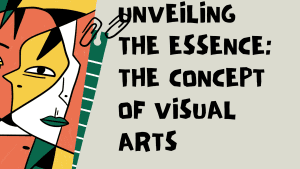
Introduction:
Visual arts, a profound and intricate realm of human expression, encompass a myriad of forms that captivate, inspire, and challenge our perceptions. The concept of visual arts transcends cultural boundaries and spans across millennia, shaping and reflecting the essence of humanity. In this exploration, we delve into the core of visual arts, unraveling its meaning, purpose, and the diverse avenues through which it unfolds.
- Defining Visual Arts: Visual arts refer to a broad spectrum of creative expressions that appeal to the sense of sight. This umbrella term encompasses traditional forms such as painting, sculpture, drawing, and printmaking, as well as contemporary mediums like photography, film, digital art, and installation. At its core, visual arts serve as a language, allowing artists to communicate complex ideas, emotions, and perspectives visually.
- The Power of Visual Communication: Visual arts serve as a potent means of communication, transcending linguistic and cultural barriers. Artists harness the power of imagery to convey narratives, evoke emotions, and provoke thought. Whether through the strokes of a brush, the lens of a camera, or the manipulation of digital pixels, visual artists communicate messages that resonate on a profound level.
- Exploring Aesthetics and Beauty: Aesthetic principles play a crucial role in visual arts, defining notions of beauty, balance, and harmony. Artists engage with elements such as color, form, texture, and composition to create visually pleasing and thought-provoking works. The concept of aesthetics evolves across cultures and time periods, reflecting changing societal values and artistic movements.
- Cultural Significance: Visual arts are deeply intertwined with culture, serving as a mirror that reflects the beliefs, traditions, and identity of a society. Cultural and historical contexts shape artistic expressions, influencing styles, themes, and the choice of mediums. From ancient cave paintings to contemporary street art, visual arts are a dynamic reflection of cultural evolution.
- Personal Expression and Creativity: At its essence, visual arts provide a platform for individual and collective expression. Artists use their creativity to bring forth unique perspectives, challenge norms, and contribute to the ever-expanding tapestry of human creativity. The act of creation becomes a form of self-discovery and a means of connecting with others on a profound level.
- The Evolution of Mediums: The concept of visual arts evolves alongside technological advancements. Traditional mediums persist, but the integration of technology has given rise to new possibilities. Digital art, virtual reality installations, and multimedia collaborations push the boundaries of what is visually conceivable, inviting audiences to engage with art in innovative ways.
- Social Commentary and Advocacy: Visual arts have the power to be a catalyst for change, serving as a medium for social commentary and advocacy. Artists often address pressing issues, challenge societal norms, and provoke critical thinking through their work. From political cartoons to powerful installations, visual artists contribute to conversations that extend beyond the confines of the art world.
Conclusion: The concept of visual arts is a multifaceted tapestry woven with threads of creativity, communication, cultural significance, and personal expression. As we navigate the rich history and diverse landscape of visual arts, we discover a medium that transcends boundaries, inviting us to explore, question, and appreciate the profound impact of visual expressions on the human experience. Whether creating, observing, or interpreting, visual arts remain a dynamic and integral part of the human narrative.







